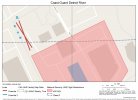Looking for advice in flying near, but not over a military base. I'm a working photojournalist with a Part107 license. Every year before the lakes and river are choked with ice, the Coast Guard takes navigational buoys out of the water and stacks them up at their base on the Detroit River. The pile of buoys seemed like a fine subject for a stock photo. I stopped at the Coast Guard security shack to alert them that I'd be flying a drone—not over any part of the base, but nearby. I had a discussion with a guard who threatened to have me arrested. Said I could not photograph any part of the base from anywhere. I asked to talk to the Officer of the Day, who turned out to be a very nice young man who admitted that he hadn't run into this issue before. I told him I had no deadline,so he said he'd research it and get back to me. So, does anyone know what the actual rules for this situation are--the FAA says I can fly and the military says no. The area where I planned to fly (see the small blue x's on the attached map) is controlled airspace, and I had FAA approval for the flight. The plan was to fly straight up, remaining over the public walking path (dotted line). The buoys are located where the large red x is, with a fence and no trespassing sign between them and the walking path. The red area is of course the base, with closed airspace. Thanks for any thoughts on this. airspace. Thanks for any help.
airspace. Thanks for any help.
 airspace. Thanks for any help.
airspace. Thanks for any help.










